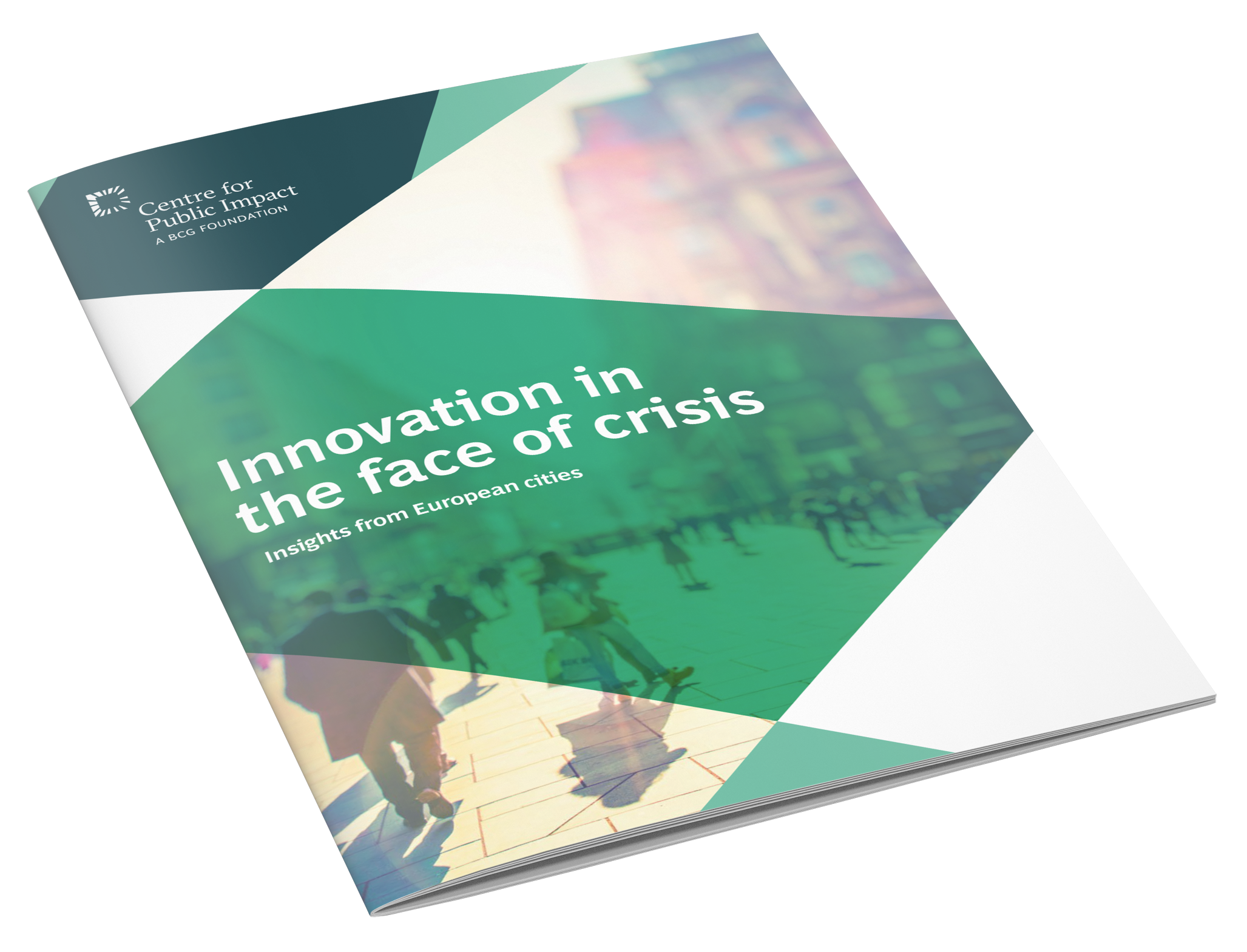
Lessons on digital equity: How the Singapore Government has been tackling the digital divide


“Digital innovation is crucial to solving today’s challenges. It requires bold leadership & commitment to changing organizational culture in a way that puts residents’ needs first." Louise Ellaway from @BloombergDotOrg
Share article.@CPI_foundation is proud to have participated in the delivery of @BloombergDotOrg’s Digital Innovation Initiative, where cities built capabilities in skills needed for successful #digitaltransformation
Share articleWhat are @CPI_foundation's key takeaways from curating a learning experience that enables cities to learn, listen, and adapt to an ever-changing landscape of digital services? Read 📖 this article to find out!
Share articleWe put our vision for government into practice through learning partner projects that align with our values and help reimagine government so that it works for everyone.
When it comes to digital transformation, the COVID-19 pandemic has made two things clear.
Firstly, digital transformation is critical to the delivery of essential public services. Secondly, meaningful and responsive resident engagement is integral. As cities look to the future, we have a huge opportunity. By building upon the global insights gained from successful digital service delivery in crisis, we can reach new heights in digital transformation.
There is certainly much to be learned from cities across Europe. CPI is proud to have participated in the delivery of the Bloomberg Philanthropies’ Digital Innovation Initiative, this programme of support for European capital cities accelerated digital innovation to improve critical services and deliver better results for residents. As part of the Initiative, programme partners TPX Impact (formerly FutureGov) supported 8 European cities to undertake transformation projects to deliver high-impact digital services.
Over 18 months, we witnessed cities overcome and persevere through unprecedented challenges. Now, those cities are maintaining a pandemic-era urgency around transformation in ways that radically reimagine cities’ relationships with residents.
Through the programme, cities have built capabilities in the different skills needed for successful digital transformation. In doing so, they have gained an innovation toolkit that enables deep listening with communities, collaboration with partners, experimentation in city halls, the co-design of services with residents, and better use of data. All of which will enable them to deliver better public services for residents going forward.
“In this moment of rapid, fundamental social change accelerated by the pandemic, we have seen that digital innovation is crucial to solving today’s challenges. It requires bold leadership and a commitment to changing organizational culture in a way that puts residents’ needs first.” Louise Ellaway, Bloomberg Philanthropies Government Innovation team
Over the course of the programme, more than 300 staff across 19 cities received training in the skills required to lead digital transformation, and new digital services were tested with the support of more than 2000 residents.
In September 2020, we also published ‘Innovation in the face of crisis’, a report telling the story of how other European capitals were using digital to live out the principles of CPI’s vision for government.

Below are some key lessons from curating a learning experience that enables our cities to listen, learn, and adapt to an ever-changing landscape for digital services.
Through this work, we’ve seen firsthand the value of a human-centred design approach, which helps practitioners learn from their complex environments and adapt their response to better meet the needs of communities.
This approach is vital when redesigning digital public services because it encourages governments to engage with citizens from the beginning of the design process. By doing this, they can develop a deeper understanding of user needs, motivations, and incentives. This has the potential to deliver a less risky digital experience, because potential problems can be identified with users from the very beginning. It also provides an opportunity to co-develop solutions with the people and communities that will be served by the product.
One city that has applied human-centred design is Helsinki. They recognised the city’s unemployment services were not producing the kind of quality interactions with jobseekers that can best help them find services and opportunities that are a good match. To explore this problem, the city held one-on-one interviews with jobseekers to hear about their experiences with city employment services, and better understand their needs. After this discovery phase, the focus shifted to testing ideas with users and finding tools to support better interactions with residents who are looking for work.
“Following the human-centred design process has shown us that before developing any tech solutions, we have to have a deep understanding of the user’s real needs and how these needs could be answered.” - Kati Rinne, Senior Planning Officer and Project Lead for Helsinki Unemployment Services
Similarly, the digital team in Vilnius adopted a human-centred approach to reimagine social care services for their aging population. Previously, people had found it difficult to navigate what services and options were available.
A team of social care workers and technologists were tasked with rethinking the front-end of these services. They carried out interviews with social care service users and spoke with the adult children of users too, because they were often the ones trying to work out how to sign up to services. They received feedback that the city’s website was unclear and confusing. “The biggest problem was information,” Egle Radvile, Chief Technology Officer says. “More or less everything was on the website, but it was impossible to find what you needed.”
In response the city rebuilt its social-care website using an iterative approach. Users tested each new design and the information provided to make sure it was clear. As new improvements were added, applications for care increased, as more people were able to find the information they needed. The city is planning to keep improving and tweaking the website by incorporating residents´ feedback on an ongoing basis.
The transformation of city services through digital innovation necessitates different ways of working which centre creative thinking, agility and enhanced collaboration with other parts of the city ecosystem. This change can be difficult, because these new ways of working challenge the status quo and often require a shift in cultures and mindsets. Nonetheless, they are crucial if cities are to design digital services that truly respond to the complexities of their communities.
Dublin City Council wanted to modernise how they deal with requests for repairs in the social housing units they manage. With a paper-based system in use, there were often delays and errors for the more than 60,000 housing repair requests received each year.
Throughout the service transformation programme they formed multidisciplinary teams to foster collaboration and ensure they maintained a holistic view of the service. As part of this, their user research included not only service users but also frontline staff, administrators and housing repairmen. Dublin quickly realised that the practitioners closest to the challenge were also closest to the solution.
Increased collaboration between teams demonstrated there was a need for more accurate and up-to-date information within the housing maintenance database. In response, the council set up an app which allowed both tradespeople to receive repair requests and tenants to access live information about repairs.
Mark Geoghegan, Area Maintenance Officer, says re-examining processes has helped create better channels of communication within the city government and supported them to break down silos.
“This project helps people who aren’t on the front line of service delivery better understand the needs of the people who are accessing the service.”
It’s easy to think digital transformation is all about flashy, sophisticated technology. Through this programme, we have seen how digital can enhance and prioritise human connection, making cities more empathetic and connected to their residents. When technology is employed with purpose and in context, digital offers new channels to empower and engage residents. The best digital services are people-first and user-centred services, designed with the community rather than for the community.
In Helsinki, Mikko Rusama’s (Chief Digital Officer) team discovered that tech was most useful for onboarding jobseekers into the system. For example, by sending text message appointment reminders for meetings with employment agents. But otherwise, what mattered most was to enable the jobseeker and employment agent to have as productive a face-to-face conversation as possible.
“One of the findings was that the quality of those interactions was critical, so the key question was how to have deeper interactions between the unemployed people and agents to have more impactful meetings,” Rusama says. “Rather than jumping to some technology solution, the team really tried to understand what is the actual problem we need to solve?”

Digital ways of working entail a test, iterate and learn approach to designing public services. Experimentation and learning from “failure” is part of this process, which offers a departure for governments who believe they must have all the answers.
Digital is also a way for governments to embrace the complexity of the world and work to problem-solve in context and with those who are closest to the problem. Experimenting, prototyping and the ability to learn every step of the way is a muscle many public servants are developing today, and which is vital for those looking to adopt new mindsets towards failure and risk.
Bratislava is charting a new way for governments to be and do through their “Living Lab” — a test bed for the city to test new technologies and solutions before investing in them. At the moment, the lab is experimenting with 600 small sensors to see if they could help the city enforce its new short-term street-parking policy by identifying how long cars have occupied a space. This test-and-learn approach is also helping the city define what problem it’s trying to solve with the technology. “The city is approached with different offers from tech companies and if you don’t know what problem you’re trying to solve, there is no framework for saying yes or no” Petra Dzurovčinová, Chief Innovation Officer said.
Sofia is another city that is embracing learning and experimentation. By fostering a two-way conversation with residents, their digital team is able to see the ongoing delivery of services as an experiment that can always be improved and built upon. The city is using a citizen-centred approach to improve the effectiveness of its services, starting with the online address registration process for residents looking to access municipal services.
“We should engage our citizens more and try to better understand their needs, and find ways of getting constant feedback,” Antonia Shalamanova, Program and Projects Expert says. “Because sometimes, there is a communication gap.” This citizen-focused approach to digitizing services has broad application and could be applied to other services in the future.
We’re incredibly proud of the contribution cities have made throughout this programme, not least whilst simultaneously managing an ongoing pandemic and delivering critical services to the residents they serve. Through our work with these cities, we have learned that human-centred design, collaboration across boundaries, human connection and ongoing experimentation all play a crucial role in the digitisation of public services, whilst simultaneously offering the chance for governments to explore new ways of being and doing.
Every city faces its own unique challenges. These principles offer a roadmap for other cities looking to use digital to improve their services, change the way they listen to and engage with residents and ultimately, create better outcomes for residents.
We’re continuing our work as a learning partner and will be offering our support to city halls and organisations doing this important work.
Want to join us? We’re always looking for new ideas, partners and fresh insights, so please reach out if you'd like to continue the conversation - we’d love to hear from you.





